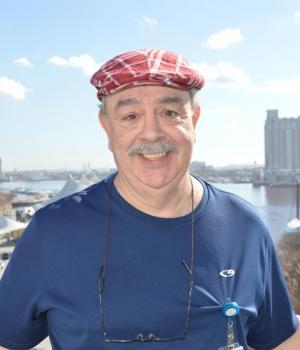Dr. Allen R. Place

Dr. Allen R. Place
Professor, Institute of Marine and Environmental Technology
Director, US HAB-CTI
In the wake of the 1997 fish kills and public concern surrounding Pfiesteria, the University of Maryland Biotechnology Institute (UMBI) scientist Al Place set out to study the algae species blamed for killing fish and sickening humans in the Chesapeake Bay and its rivers. To aid in the study, Place and his team got hold of another algae, Gyrodinium galatheanum (now called Karlodinium veneficum), to serve as a comparison to their species of interest, Pfiesteria. Both Karlodinium and Pfiesteria are dinoflagellates —one-celled algae that propel through water with whip-like flagella. Things took an unexpected turn researchers found that Karlodinium actually appeared more toxic than Pfiesteria. Further study has led Place to suspect that Karlodinium was the real culprit in the so-called “Pfiesteria hysteria” of 1997. He has spent the last twenty-five years researching the microscopic algal cell at Institute of Marine and Environmental Technology (formerly COMB) in Baltimore. Every year since then, blooms of Karlodinium have been implicated in fish kills along the Atlantic coast as well as worldwide. The nature of fish kills can be traced to production of a unique polyketide toxin similar in structure to amphidinol. The toxin is made to assist in prey capture (i.e. cryptophytes) through formation of a nonspecific pore upon complexation with prey’s sterol brassicasterol. In colloboration with Mark Hamann at the University of Mississippi the complete absolute structure for one of the karlotoxins has been determined. This was no small feat given the complexity of the molecule. An additional 14 structures have been solved and will be submitted for publication in the near future. These compounds have intriguing cholesterol binding properties which could be exploited in a variety of ways as a drug lead. Through NSF funding (PI S. Lin) he was part of a team that has produced the largest full length cDNA library available for a dinoflagellate species. With NIH/NSF Ocean and Human Health funding, the complete transcriptome of several dinoflagellates have been obtained. This has provided sequence information for rare transcripts (e.g. proton channel, and phosphopantetheinyl transferase) that have been used for heterologous mammalian expression to validate function. The laboratory has annotated several hundred putative PKS sequences that are involved in either fatty acid synthesis or polyketide synthesis. He has experience in growing hundreds of liters of dinoflagellate culture and isolating proteins for enzymatic and proteomic analysis.
In 2010, he received one of the first PCM HAB grants, Mitigating Microcystis in the Chesapeake (MMIC), and is well versed in the mitigation strategies. He was Vice-Chairman for the June 2017 Gordon Research Conference, Mycotoxin and Phycotoxin and Chair for the June 2019 Gordon Research Conference, Mycotoxin and Phycotoxin. In addition the PI hosted in Baltimore the 9th Symposium on Harmful Algae in the US in November 2017 with over 330 attendees, video-taped the presentations and have the presentations available on the meeting website for archival viewing.